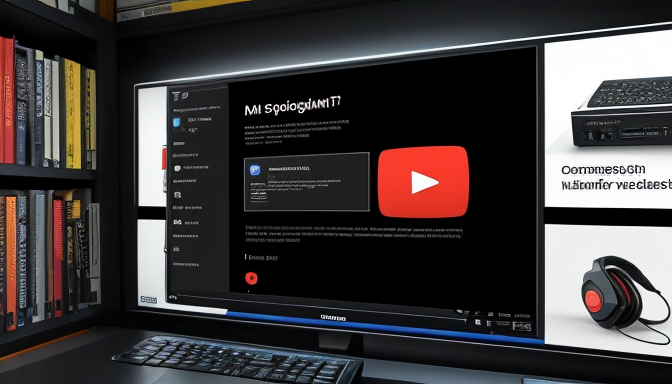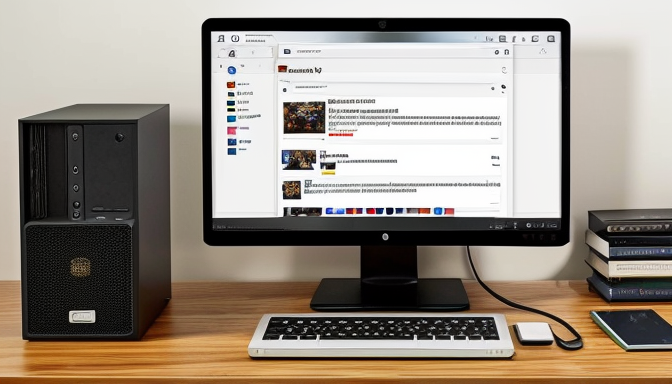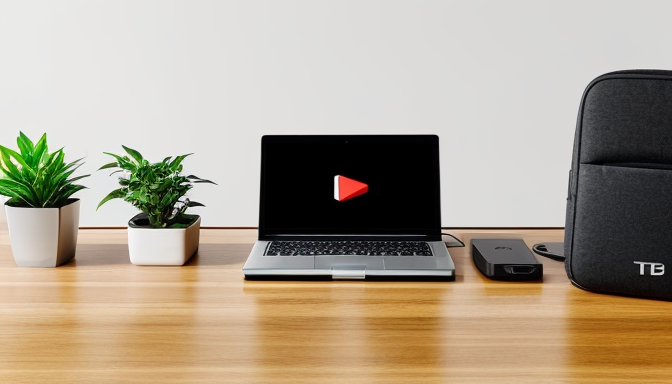
YouTube Download Video and Audio: Comprehensive Preservation Techniques
This article delves into effective strategies for downloading YouTube videos and audio, offering valuable insights, tips, and tools to help you successfully preserve your favorite content.
Understanding YouTube’s Terms of Service
Before you start downloading content, it is essential to familiarize yourself with YouTube’s terms of service. This knowledge not only ensures compliance but also helps you avoid potential legal complications.
Why Download YouTube Videos and Audio?
There are numerous reasons to download YouTube content. Whether it’s for offline viewing, preserving content for future use, or personal enjoyment, understanding these motivations can guide users in making informed decisions.
Tools for Downloading YouTube Videos
Various tools are available for downloading YouTube videos, ranging from browser extensions to dedicated software. Exploring these options helps users identify the best solutions for their specific needs.
- Browser Extensions: These tools provide a convenient way to download videos directly from YouTube. They are typically easy to install and offer a user-friendly interface.
- Desktop Software: For users needing advanced features like batch downloading and format conversion, dedicated desktop software is an excellent choice.
- Online Download Services: These web-based solutions allow users to download videos without needing to install software, making them accessible from any internet-enabled device.
How to Download YouTube Audio
Downloading audio from YouTube is beneficial for creating playlists or enjoying music offline. Various methods simplify this process.
- Audio Extraction Tools: These specialize in converting YouTube videos into audio files, often supporting multiple formats for user convenience.
- Mobile Apps for Audio Downloading: These applications enable users to download audio directly to their smartphones or tablets, often including features like playlists and offline access.
Best Formats for Downloading YouTube Content
Choosing the right format is crucial for maintaining quality and compatibility. Understanding the different formats available can aid users in making the best choice.
- Video Formats: MP4 vs. MKV: MP4 is widely compatible, while MKV offers higher quality and additional features for advanced users.
- Audio Formats: MP3 vs. WAV: MP3 is compressed and portable, whereas WAV provides superior quality but larger file sizes.
Ensuring Quality During Download
To maintain the quality of downloaded content, consider the following tips:
- Choosing the Right Resolution: Selecting the appropriate resolution can significantly affect video quality. Users should consider their device capabilities and intended use.
- Using Reliable Download Sources: Utilizing trusted tools minimizes the risk of poor quality or malware. Researching and reading reviews can help identify reliable options.
Legal Considerations When Downloading Content
Understanding the legal implications of downloading YouTube content is vital. Familiarizing yourself with copyright laws and YouTube’s policies can help avoid potential infringements.
- Fair Use vs. Copyright Infringement: Navigating this complex area requires awareness of when downloading content is permissible.
- Attribution and Content Sharing: Proper attribution is necessary when sharing downloaded content to respect creators’ rights.
Conclusion: Best Practices for Downloading YouTube Content
In conclusion, downloading YouTube videos and audio involves careful consideration of tools, formats, and legal aspects. By following best practices, users can successfully preserve their favorite content while respecting copyright laws.

Understanding YouTube’s Terms of Service
Before diving into the process of downloading content from YouTube, it is essential to have a thorough understanding of YouTube’s Terms of Service. These terms outline the rules and guidelines that govern the use of the platform, including restrictions on downloading videos and audio. Ignoring these terms can lead to serious legal ramifications, including copyright infringement claims.
YouTube explicitly states that users are not allowed to download any content unless a download button or link is provided by the platform. This means that while you may find various tools and software that facilitate downloading, using them can violate YouTube’s policies. Therefore, it is crucial to ensure that any downloading activity is compliant with these terms.
Moreover, understanding the implications of copyright laws is vital. Most videos on YouTube are protected by copyright, meaning that the content creators retain exclusive rights to their work. Downloading and distributing this content without permission can be considered a violation of these rights. Users must familiarize themselves with the concept of fair use, which allows limited use of copyrighted material under specific conditions, but this is often a gray area that requires careful consideration.
In addition to legal concerns, respecting the rights of content creators is important for maintaining a healthy online community. When downloading content, users should always consider giving proper attribution to the original creators, fostering a culture of respect and acknowledgment.
In conclusion, understanding YouTube’s terms of service is not just a matter of compliance, but also a means to support and respect the hard work of content creators. By adhering to these guidelines, users can enjoy their favorite content responsibly and ethically.

Why Download YouTube Videos and Audio?
Downloading YouTube videos and audio has become increasingly popular for a variety of reasons. Understanding these motivations can help users make informed choices about how they engage with content on the platform.
- Offline Viewing: One of the primary reasons users choose to download YouTube content is to enjoy videos without an internet connection. This is particularly useful for individuals who travel frequently or have limited access to reliable internet.
- Content Preservation: Users may also want to preserve their favorite videos for personal libraries. This ensures that cherished content remains accessible, even if it gets removed from the platform.
- Personal Use: Some users download content for personal projects, such as creating montages or educational materials. Having access to videos offline allows for greater flexibility in how the content is used.
- Educational Purposes: Students and educators often download lectures or tutorials for offline study. This can enhance learning experiences by allowing users to revisit important information at their convenience.
- Curating Playlists: By downloading audio from YouTube, users can create personalized playlists for various occasions, such as workouts, parties, or relaxation. This customization enhances the listening experience.
In summary, the motivations for downloading YouTube videos and audio are diverse and can significantly enhance user experience. By understanding these reasons, users can make more informed decisions about their content consumption.

Tools for Downloading YouTube Videos
In the digital age, the ability to download videos from platforms like YouTube has become increasingly important for many users. Whether for offline viewing, educational purposes, or content preservation, having the right tools can make all the difference. Below, we explore a variety of tools available for downloading YouTube videos, each catering to different user needs.
- Browser Extensions: Browser extensions are among the most popular tools for downloading YouTube videos. They integrate seamlessly with web browsers, allowing users to download videos directly from the YouTube page with just a few clicks. Extensions like Video DownloadHelper and SaveFrom.net are user-friendly and often free, making them accessible to a wide audience.
- Desktop Software: For those who require more advanced features, dedicated desktop software is an excellent choice. Programs like 4K Video Downloader and YTD Video Downloader offer options for batch downloading, format conversion, and even video editing capabilities. These tools are ideal for users who frequently download content and need robust functionality.
- Online Download Services: Online services provide a convenient way to download videos without the need for software installation. Websites like Y2Mate and KeepVid allow users to paste the video URL and choose their desired format for download. This method is particularly useful for users on the go or those using devices with limited storage.
- Mobile Apps: With the rise of smartphones, mobile applications have become essential for downloading YouTube videos. Apps such as TubeMate and VidMate enable users to download videos directly to their mobile devices. These apps often include features like playlist management and offline viewing, enhancing the user experience.
In conclusion, the variety of tools available for downloading YouTube videos ensures that every user can find a solution that fits their specific needs. From browser extensions to dedicated software and mobile apps, exploring these options can help streamline the downloading process and enhance the overall experience.
Browser Extensions
have revolutionized the way users interact with websites, particularly when it comes to downloading videos from YouTube. These handy tools integrate seamlessly into your web browser, offering a straightforward and efficient method for obtaining your favorite video content.
One of the primary advantages of using browser extensions is their ease of installation. Most extensions can be added to your browser with just a few clicks, eliminating the need for complicated setups or software downloads. Once installed, these extensions typically provide a user-friendly interface that allows for quick and hassle-free downloads. Users can simply navigate to the YouTube video they wish to download, and with a single click, the extension will initiate the download process.
Moreover, many browser extensions offer additional features that enhance the downloading experience. For instance, some allow users to choose the video quality before downloading, ensuring that they receive the content in their preferred format. Others may support multiple video formats, giving users the flexibility to select options that best suit their needs.
It’s also worth noting that browser extensions often receive regular updates, which means they can adapt to any changes in YouTube’s platform. This ensures that users can continue to download videos without interruption, even as the website evolves.
However, while browser extensions are convenient, users should be cautious about the sources they choose. Not all extensions are created equal; some may contain malware or violate YouTube’s terms of service. Therefore, it is crucial to research and select reputable extensions that have positive reviews and a solid user base.
In conclusion, browser extensions provide a practical and efficient way to download videos from YouTube. With their ease of use, additional features, and the ability to keep up with platform changes, they are an invaluable tool for anyone looking to preserve their favorite content. Just remember to choose wisely and stay informed about the legal implications of downloading content.
Desktop Software
for downloading YouTube videos offers users a powerful solution for managing their video library. Unlike browser extensions or online services, dedicated desktop applications provide a range of advanced features that cater to the needs of serious users.
One of the most significant advantages of using is the ability to perform batch downloading. This feature allows users to download multiple videos simultaneously, saving time and effort. For individuals who frequently download content, this capability can be a game-changer, enabling them to queue up several videos for download and walk away while the software works.
Additionally, many desktop applications come equipped with format conversion tools. This means users can download videos in various formats, such as MP4, AVI, or MKV, depending on their specific needs. For instance, if a user wants to play a video on a specific device that only supports certain formats, they can easily convert the downloaded file to the required format without needing third-party software.
Moreover, desktop software often includes features like video quality selection, allowing users to choose the resolution of the video they wish to download. This is particularly useful for those who want to conserve storage space or ensure compatibility with their devices.
Another benefit is the enhanced stability and speed of downloads. Desktop applications are generally less prone to interruptions caused by browser crashes or internet connectivity issues. They can also utilize advanced technologies to optimize download speeds, ensuring that users can quickly access their desired content.
In summary, dedicated desktop software provides a comprehensive suite of tools for downloading YouTube videos. With features such as batch downloading, format conversion, and enhanced stability, these applications are ideal for users who require more functionality and efficiency in managing their video content.
Online Download Services
Online download services have revolutionized the way users can access and save multimedia content from the internet. These platforms offer a convenient and efficient means of downloading videos and audio files without the need for installing any software on your device. This flexibility makes them an attractive option for users who may not have the technical expertise or the desire to clutter their devices with additional applications.
- Accessibility: One of the main advantages of online download services is their accessibility. Users can access these services from any device with an internet connection, whether it’s a laptop, tablet, or smartphone. This means you can download your favorite videos or audio tracks on the go, without being tied to a specific machine.
- User-Friendly Interfaces: Most online download services feature straightforward and intuitive interfaces. This simplicity allows even the most novice users to navigate the process with ease, ensuring that anyone can download content without a steep learning curve.
- Variety of Formats: Many of these services offer the ability to choose from various formats for your downloads. Whether you prefer MP4 for videos or MP3 for audio, you can often select the format that best suits your needs, ensuring compatibility with your devices.
- No Installation Required: Since these services operate entirely online, there’s no need to worry about software updates or compatibility issues that can arise with installed applications. This aspect also enhances security, as users are less likely to download potentially harmful software.
In conclusion, online download services provide a hassle-free solution for downloading videos and audio from various platforms. Their convenience, accessibility, and user-friendly nature make them a popular choice among users looking to save content for offline enjoyment. As technology continues to evolve, these services are likely to become even more sophisticated, offering enhanced features and improved user experiences.

How to Download YouTube Audio
Downloading audio from YouTube can be a game-changer for music lovers and content creators alike. By extracting audio from your favorite videos, you can create personal playlists, enjoy music offline, and even use audio clips for projects. This process has become increasingly simple and efficient thanks to various tools and methods available today.
One of the primary reasons for downloading YouTube audio is the ability to listen to your favorite tracks without needing an internet connection. This is particularly useful for long commutes, workouts, or when traveling to areas with limited connectivity. Additionally, having audio files allows you to curate playlists tailored to your preferences, enhancing your listening experience.
There are several effective methods to download audio from YouTube:
- Audio Extraction Tools: These specialized tools convert YouTube videos into audio files, typically in formats like MP3 or WAV. They are user-friendly and often allow users to choose the desired output quality.
- Mobile Applications: For those who prefer downloading directly to their smartphones or tablets, various mobile apps are available. These apps often come with features like playlist management and offline listening capabilities.
- Online Services: Numerous websites offer online services for downloading YouTube audio. Users can simply paste the video URL, select their preferred audio format, and download the file without installing any software.
When downloading audio, it’s essential to consider the format. MP3 is a widely used format due to its balance between quality and file size, making it ideal for portable devices. On the other hand, WAV offers higher quality but results in larger files, which may not be suitable for all users.
In conclusion, downloading audio from YouTube provides numerous benefits, from offline listening to personalized playlists. By utilizing the right tools and understanding the available formats, users can enhance their audio experience while enjoying their favorite content.
Audio Extraction Tools
are specialized applications designed to convert YouTube videos into audio files, making it easier for users to enjoy their favorite content in a portable format. These tools cater to a variety of needs, whether for music, podcasts, or educational content, and they often support multiple audio formats.
One of the primary advantages of using audio extraction tools is their flexibility in output options. Users can choose from popular formats such as MP3, WAV, and AAC, allowing them to select the best fit for their devices and preferences. For instance, MP3 is widely recognized for its compression capabilities, making it ideal for mobile devices with limited storage. In contrast, WAV files offer higher quality, suitable for audiophiles who prioritize sound fidelity.
When considering an audio extraction tool, it is essential to evaluate its user interface and ease of use. Many tools feature straightforward designs that allow users to simply paste the YouTube video URL, select the desired format, and initiate the conversion process. This simplicity is particularly beneficial for those who may not be tech-savvy.
Moreover, some audio extraction tools come equipped with advanced features such as batch processing, which enables users to convert multiple videos simultaneously. This can save time and streamline the workflow for users who need to extract audio from several sources.
Another aspect to consider is the quality of the extracted audio. Reputable audio extraction tools ensure that the audio quality remains high, even after conversion. Users should look for tools that provide options for adjusting bitrate and sample rates to optimize sound quality according to their needs.
In conclusion, audio extraction tools are invaluable for anyone looking to convert YouTube videos into audio files. With a variety of formats, user-friendly interfaces, and additional features, these tools cater to diverse user needs and preferences, making it easier than ever to enjoy content on the go.
Mobile Apps for Audio Downloading
Mobile Applications for Downloading YouTube Audio have revolutionized the way users interact with their favorite music and audio content. These applications allow for seamless downloads directly to smartphones and tablets, providing convenience and flexibility for users on the go.
One of the primary benefits of these mobile apps is the user-friendly interface they offer. Most apps are designed with simplicity in mind, allowing even the least tech-savvy individuals to navigate with ease. Once installed, users can quickly search for their desired YouTube videos and initiate downloads with just a few taps.
In addition to basic downloading capabilities, many of these applications come equipped with advanced features. For instance, users can create customized playlists that allow them to organize their favorite tracks efficiently. This feature is particularly useful for those who enjoy curating their music collections for different occasions, such as workouts, commutes, or relaxation.
Another significant advantage of mobile apps for audio downloading is offline access. Users can download audio files and listen to them without needing an internet connection, making it perfect for travel or areas with limited connectivity. This functionality ensures that users can enjoy their favorite content anytime, anywhere.
Moreover, many of these apps support various audio formats, enabling users to choose the best quality for their needs. Whether it’s the widely used MP3 format for portability or higher-quality options like WAV, users have the flexibility to select what suits them best.
In summary, mobile applications for downloading YouTube audio not only simplify the process of accessing beloved content but also enhance the overall user experience through features like playlists and offline listening. As technology continues to evolve, these apps will likely become even more sophisticated, making it easier for users to enjoy their favorite audio content.

Best Formats for Downloading YouTube Content
Choosing the right format for downloaded content can significantly impact both quality and compatibility. With an array of formats available, understanding the nuances of each can empower users to make the best decisions tailored to their needs.
- Video Formats
- MP4: This format is highly popular due to its broad compatibility across devices and platforms. It balances quality and file size, making it ideal for most users.
- MKV: While MKV files can support higher quality and additional features like multiple audio tracks and subtitles, they may not be as widely compatible with all devices.
- Audio Formats
- MP3: Known for its compression capabilities, MP3 is the go-to format for those looking to save space while maintaining decent audio quality. It is widely supported across all devices.
- WAV: This format offers superior audio quality but results in larger file sizes. It is suitable for audiophiles or anyone prioritizing sound fidelity over storage space.
When selecting a format, consider the following factors:
1. Device Compatibility: Ensure the format you choose is supported by your intended device.2. Quality vs. Size: Balance the need for high quality with the available storage space.3. Intended Use: Consider whether the content will be used for casual viewing or professional purposes.
In conclusion, understanding the differences between video and audio formats is essential for optimizing the experience of downloaded YouTube content. By making informed choices, users can enjoy their favorite media without sacrificing quality or compatibility.
Video Formats: MP4 vs. MKV
When it comes to video formats, MP4 and MKV are two of the most widely used types, each offering unique advantages tailored to different user needs.
MP4: The Universal Format
- Compatibility: MP4 is renowned for its broad compatibility across various devices and platforms. Whether you are using a smartphone, tablet, or desktop, MP4 files can be played seamlessly.
- Compression: This format utilizes efficient compression algorithms, ensuring that the video quality remains high while minimizing file size. This is particularly advantageous for users with limited storage space.
- Streaming: MP4 is optimized for streaming, making it ideal for online platforms like YouTube and social media. Its adaptability allows for smooth playback even on slower internet connections.
MKV: The Feature-Rich Format
- Quality: MKV files often offer superior quality compared to MP4, supporting higher resolutions and bitrates. This makes it a preferred choice for video enthusiasts who prioritize visual fidelity.
- Multiple Streams: One of the standout features of MKV is its ability to contain multiple audio and subtitle tracks within a single file. This flexibility is especially useful for multilingual content.
- Advanced Features: MKV supports advanced features like chapter markers, making it easier for users to navigate long videos. This format is often favored for storing high-definition films and documentaries.
Conclusion: Choosing the Right Format
In summary, the choice between MP4 and MKV largely depends on your specific needs. If you prioritize compatibility and storage efficiency, MP4 is the way to go. However, if you seek higher quality and additional features, MKV is an excellent option. Understanding these differences can help you make informed decisions when downloading or creating video content.
Audio Formats: MP3 vs. WAV
When it comes to downloading audio files, users often encounter various formats, with MP3 and WAV being among the most popular. Each format serves distinct purposes and caters to different user preferences.
MP3 is a widely used audio format known for its compression capabilities. This means that it reduces the file size significantly while maintaining a reasonable level of sound quality. The compact nature of MP3 files makes them highly portable, allowing users to store thousands of songs on their devices without consuming too much storage space. This format is particularly favored by those who prioritize ease of sharing and streaming over the highest possible sound fidelity.
On the other hand, WAV files are uncompressed and offer a much higher sound quality. This format is often preferred by audio professionals and enthusiasts who require pristine audio for editing, mixing, or producing music. However, the trade-off is that WAV files are significantly larger than MP3s, which can make them less convenient for everyday use, especially on devices with limited storage capacity.
When choosing between MP3 and WAV, consider your specific needs:
- If you need to save space and want to listen to music on the go, MP3 is the ideal choice.
- If you’re working on a project that demands high-quality audio, such as music production or sound design, WAV is the better option.
In conclusion, both MP3 and WAV formats have their unique advantages. Understanding these differences can help users make informed decisions based on their audio needs, whether for casual listening or professional use.

Ensuring Quality During Download
Maintaining the quality of downloaded content is essential for an enjoyable experience. When users download videos or audio from platforms like YouTube, the integrity of the files can significantly affect their viewing or listening pleasure. Here are several tips to help users preserve the integrity of their files:
- Choosing the Right Resolution: Selecting the appropriate resolution is crucial. Higher resolutions offer better quality, but they also require more storage space. Users should consider their device capabilities and intended use when making this choice. For example, if downloading for a mobile device, a resolution of 720p may be sufficient.
- Using Reliable Download Sources: It is vital to utilize trusted tools and sources for downloading. Using unreliable websites or software can lead to poor quality files or even malware. Researching and reading reviews can help identify reliable options.
- Checking File Formats: Different file formats have varying qualities. For videos, formats like MP4 and MKV are popular, with MP4 being widely compatible. For audio, MP3 and WAV are common, where MP3 is compressed for portability, while WAV offers higher quality.
- Monitoring Download Speed: A stable and fast internet connection can enhance the download process. Slow downloads can lead to corrupted files, so users should ensure they have a reliable connection before starting.
- Avoiding Interruptions: It’s important to avoid interruptions during the download process. Closing other applications or devices that may use bandwidth can help ensure a smoother download experience.
By following these tips, users can maximize the quality of their downloaded content, ensuring a more enjoyable experience whether they are watching videos or listening to music.
Choosing the Right Resolution
When it comes to downloading videos, resolution plays a crucial role in determining the overall quality of the content. Selecting the appropriate resolution can significantly impact your viewing experience, and several factors should be taken into account to make an informed choice.
- Device Capabilities: Different devices have varying display capabilities. For instance, a smartphone may not effectively showcase 4K resolution, while a 4K television will. Always consider the maximum resolution your device can support to avoid unnecessary file sizes.
- Internet Speed: High-resolution videos require faster internet speeds for smooth playback. If your connection is slow or unstable, opting for a lower resolution can enhance your viewing experience by reducing buffering.
- Intended Use: Think about how you plan to use the downloaded video. If it’s for casual viewing on a mobile device, lower resolutions like 720p may suffice. However, for projects requiring high detail, such as editing or presentations, higher resolutions like 1080p or 4K are advisable.
- Storage Space: Higher resolutions result in larger file sizes, which can quickly consume storage space on your device. Assess your available storage before selecting a resolution to avoid complications later.
- Content Type: The type of content also matters. For action-packed videos, higher resolutions can provide a more immersive experience, while lower resolutions may be acceptable for slower-paced content like tutorials.
In conclusion, making the right choice regarding video resolution is essential for achieving the best quality based on your specific needs and circumstances. By considering device capabilities, internet speed, intended use, storage space, and content type, you can ensure a satisfying viewing experience without compromising quality.
Using Reliable Download Sources
When it comes to downloading content from platforms like YouTube, utilizing trusted tools and sources is essential. This practice not only minimizes the risk of encountering poor quality downloads but also significantly reduces the chances of exposing your device to malware and other security threats. With the vast array of options available online, it’s crucial to approach downloading with a discerning eye.
One effective strategy is to conduct thorough research before selecting a downloading tool or service. Start by checking user reviews and ratings on reputable tech websites or forums. These reviews often provide valuable insights into the reliability and performance of different tools. Look for feedback that highlights the ease of use, download speed, and overall satisfaction of previous users.
Another aspect to consider is the developer’s reputation. Established developers with a history of creating reliable software tend to prioritize user safety and experience. It’s advisable to avoid unknown or lesser-known tools, as they may not have undergone rigorous testing and could pose risks to your device.
Additionally, consider utilizing tools that offer security features, such as virus scanning and secure download protocols. These features can provide an extra layer of protection, ensuring that the files you download are safe and free from harmful elements.
To further enhance your downloading experience, maintain an updated antivirus program on your device. This precaution can help detect any potential threats that may arise during the downloading process. Remember, a little caution goes a long way in ensuring a smooth and secure downloading experience.
In summary, taking the time to research and choose reliable downloading sources is crucial. By doing so, you can enjoy high-quality downloads while safeguarding your device from potential threats.

Legal Considerations When Downloading Content
Understanding the legal implications of downloading content from YouTube is not just advisable, but essential for users who wish to avoid potential legal pitfalls. The internet is a vast resource, and while it offers a plethora of content, it also comes with responsibilities. Familiarizing oneself with copyright laws and YouTube’s specific policies can significantly reduce the risk of infringement.
Firstly, it’s important to recognize that most content on YouTube is protected by copyright. This means that downloading videos or audio without permission from the copyright holder can lead to legal consequences. Users should be aware that YouTube’s Terms of Service explicitly prohibit downloading unless a download button or link is clearly provided by the platform.
Another critical aspect to consider is the concept of fair use. This legal doctrine allows for limited use of copyrighted material without permission under certain conditions, such as commentary, criticism, or educational purposes. However, determining whether a specific use qualifies as fair use can be complex and often requires legal expertise.
Moreover, when sharing any downloaded content, proper attribution to the original creator is necessary. This not only respects the rights of the content creators but also fosters a more ethical online community. Users should always strive to credit the source and, when possible, seek explicit permission before sharing.
In conclusion, navigating the legal landscape of downloading YouTube content requires diligence and awareness. By understanding copyright laws, YouTube’s policies, and the principles of fair use, users can enjoy their favorite content while respecting the rights of creators. Always remember, when in doubt, it’s best to seek guidance or refrain from downloading.
Fair Use vs. Copyright Infringement
Navigating the line between fair use and copyright infringement can be a challenging endeavor, especially in the digital age where content is easily accessible and shareable. Understanding the nuances of copyright law is essential for anyone who engages with online media. This section aims to clarify the circumstances under which downloading content is permissible, helping users make informed decisions.
What is Fair Use?
Fair use is a legal doctrine that allows limited use of copyrighted material without requiring permission from the rights holders. It is crucial to recognize that fair use is not a blanket permission; rather, it is determined on a case-by-case basis. The following factors are typically considered:
- Purpose and Character of Use: Non-commercial, educational, or transformative uses are more likely to be considered fair use.
- Nature of the Copyrighted Work: Use of factual works is more likely to qualify as fair use compared to creative works.
- Amount and Substantiality: Using a small portion of a work may favor fair use, but if the portion used is considered the “heart” of the work, it may not.
- Effect on the Market: If the use negatively impacts the market for the original work, it is less likely to be deemed fair use.
Copyright Infringement Explained
Copyright infringement occurs when a copyrighted work is used without permission from the copyright owner. This can include downloading, sharing, or distributing content illegally. Engaging in copyright infringement can lead to legal consequences, including fines and potential lawsuits.
Understanding the Balance
To navigate the fine line between fair use and copyright infringement, users should consider the purpose of their download. If the intention is for personal use, educational purposes, or commentary, it may fall under fair use. However, if the content is to be redistributed or used for profit, it is essential to seek permission from the copyright holder.
In conclusion, while the digital landscape offers vast resources, it is vital to approach downloading content with an understanding of copyright laws. By recognizing the principles of fair use and the implications of copyright infringement, users can enjoy content responsibly and legally.
Attribution and Content Sharing
When it comes to sharing downloaded content, proper attribution is not just a courtesy; it is a fundamental practice that respects the rights of creators. In an age where digital content is easily accessible, understanding how to give credit to original sources is paramount. This practice not only acknowledges the hard work and creativity of content creators but also fosters a respectful online community.
Attribution involves citing the original creator of the content, which can include videos, music, images, or written works. This is essential for several reasons:
- Legal Compliance: Many countries have copyright laws that protect creators’ rights. Proper attribution helps avoid potential legal issues associated with copyright infringement.
- Encouraging Creativity: When creators see that their work is being recognized, it motivates them to continue producing high-quality content. This creates a positive feedback loop in the creative community.
- Building Trust: Crediting sources builds trust among users. It shows that you value the work of others and are committed to ethical practices.
To effectively credit original sources, consider the following tips:
- Include the Creator’s Name: Always mention the name of the creator or the organization behind the content.
- Link Back to the Original Work: If possible, provide a hyperlink to the original content. This not only gives credit but also directs others to the source.
- Specify the License: If the content is under a specific license (like Creative Commons), mention it to inform others about how they can use the content.
In conclusion, proper attribution is crucial when sharing downloaded content. It not only respects the rights of content creators but also contributes to a more ethical and supportive online environment. By understanding and implementing these practices, we can all play a part in nurturing a community that values creativity and respects intellectual property.

Conclusion: Best Practices for Downloading YouTube Content
In summary, the process of downloading YouTube videos and audio is not as straightforward as it may seem. It necessitates a thorough understanding of various factors, including the selection of appropriate tools, formats, and legal considerations.
First and foremost, it is essential to choose the right downloading tools. There are numerous options available, from browser extensions to dedicated software and online services. Each tool has its unique features and benefits, so users should assess their individual needs to select the most suitable option.
Secondly, selecting the proper format is crucial for maintaining the quality of the downloaded content. For video, formats like MP4 and MKV are popular, with MP4 offering broad compatibility and MKV providing higher quality. Similarly, for audio, users often choose between MP3 and WAV, depending on whether they prioritize file size or audio fidelity.
Moreover, understanding YouTube’s terms of service is vital to avoid any legal repercussions. Users should familiarize themselves with copyright laws and the concept of fair use to ensure they are not infringing on creators’ rights. Proper attribution when sharing content is also important in fostering a respectful online community.
To enhance the quality of downloaded content, users should consider the resolution and ensure they are using reliable sources. This not only preserves the integrity of the files but also minimizes the risk of malware.
In conclusion, by adhering to these best practices, users can effectively download and preserve their favorite YouTube content while respecting the legal frameworks in place. This careful approach ensures a satisfying experience without compromising on quality or legality.
Frequently Asked Questions
- Is it legal to download YouTube videos?
Downloading YouTube videos can be a gray area legally. While YouTube’s terms of service generally prohibit downloading content without permission, there are exceptions for personal use under fair use. Always check copyright laws and YouTube’s policies to stay compliant.
- What tools can I use to download YouTube videos?
There are several tools available for downloading YouTube videos, including browser extensions, desktop software, and online services. Each option has its pros and cons, so consider your needs before choosing the best one for you!
- What is the best format to download videos?
The best format often depends on your needs. For general use, MP4 is widely compatible and offers good quality. If you’re looking for higher quality and don’t mind larger file sizes, MKV might be the way to go.
- Can I download audio from YouTube?
Absolutely! There are specific tools designed for audio extraction that can convert YouTube videos into audio files. Popular formats include MP3 for portability and WAV for higher quality.
- How can I ensure the quality of downloaded content?
To maintain quality, choose the right resolution based on your device’s capabilities. Additionally, always use reliable download sources to minimize the risk of poor-quality files or malware.